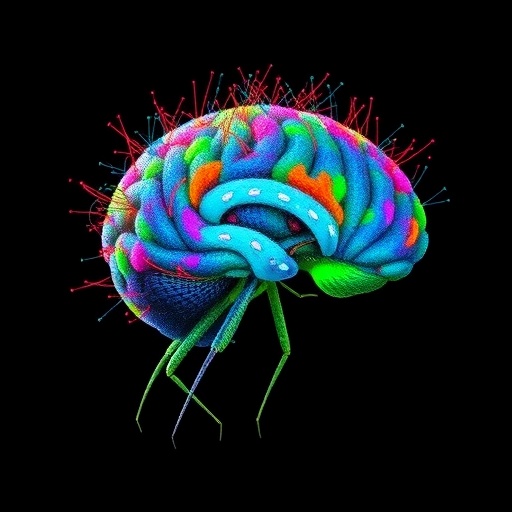In a groundbreaking study published in BMC Genomics, researchers led by Ramirez, Zuniga, and Ochoa have explored the intricate workings of the adult Drosophila brain transcriptome through long-read sequencing technologies. This comprehensive analysis sheds light on both physiological and pathological states, providing invaluable insights into the complex genetic mechanisms that underlie brain function and pathology. The research not only adds depth to our understanding of Drosophila as a model organism but also holds potential implications for broader neurological studies.
Long-read sequencing technology has transformed the landscape of genomics by allowing researchers to capture more extensive segments of DNA or RNA, thereby providing a more comprehensive view of the transcriptome. The ability to assemble transcripts without the complications posed by repetitive sequences represents a significant leap from traditional short-read methods. This technological advancement facilitates the discovery of previously uncharacterized genes and isoforms that play crucial roles in brain biology.
The study harnessed this technology to dive deep into the transcriptomic landscape of the adult Drosophila brain, revealing a multitude of expressed genes and their variations under different conditions. By comparing samples from flies in both healthy and pathological states, the researchers were able to map the effects of various stressors on gene expression. This comparison could illuminate the molecular pathways that are disrupted in neurodegenerative diseases and other brain disorders.
One of the pivotal findings of this research was the identification of specific gene expression patterns associated with neuronal activity. The analysis revealed that certain genes were upregulated in response to environmental stressors, while others showed reduced expression. Such findings suggest a dynamic regulatory network that could be crucial for maintaining neuronal health or, conversely, exacerbating disease processes. The researchers theorized that these patterns may serve as potential biomarkers for early diagnosis in various neurodegenerative conditions.
Furthermore, the team utilized advanced bioinformatics tools to analyze the long-read data. They employed algorithms designed for the assembly and annotation of complex transcriptomes, which were vital in dealing with the substantial data generated. The incorporation of machine learning techniques allowed for the efficient prediction of gene function and interaction, offering a comprehensive overview of gene networks in the Drosophila brain.
The ramifications of this research extend beyond the confines of Drosophila. As a key model organism, findings from this study could inform our understanding of vertebrate systems, including humans. The conservation of many genes across species means that pathways uncovered in fruit flies may have parallels in human neurobiology, especially in the context of aging and neurodegeneration.
Additionally, the researchers emphasized the importance of studying the transcriptome in different conditions. By examining the brain under physiological conditions, they provided a baseline against which pathological changes could be measured. This dual approach ensures that researchers can not only identify what goes wrong in diseases but also appreciate how normal brain functions might become dysregulated in response to external factors.
Moreover, the insights gained from this work contribute to the growing field of personalized medicine. As researchers understand the nuances of gene expression in various neurological contexts, they may pave the way for tailored therapeutic strategies that could modulate specific pathways to counteract neurological diseases. This is particularly crucial as we move towards more individualized healthcare solutions.
Another significant aspect of the study was the collaborative effort among researchers from different disciplines, including molecular biology, genomics, and bioinformatics. Such interdisciplinary approaches are becoming essential in modern scientific inquiries, particularly in complex fields like neuroscience. The melding of expertise not only enhances the robustness of the research but also fosters innovation in methods and applications.
The implications of the study resonate through both academic and clinical circles. As the scientific community grapples with the complexity of brain disorders, findings such as those reported in this paper highlight the critical role that model organisms play in uncovering fundamental biological truths. Each step taken towards understanding the genetic underpinnings of the brain equips researchers with tools to tackle human diseases more effectively.
As further research builds on these findings, it will be crucial to replicate and expand upon the observed gene expression patterns. Future studies may involve functional assays to directly assess the impact of identified genes on neuronal health and disease progression. Such investigations will undoubtedly deepen our comprehension of the biological processes at work in both healthy and diseased brains.
In conclusion, this pioneering research serves as a beacon for future inquiries in brain genomics. By leveraging long-read sequencing technologies, the authors have opened new avenues for exploration in the functioning of the Drosophila brain, promising to enhance our understanding of neural biology and the molecular underpinnings of disease. The broader impacts of their work will likely reverberate through the field of neuroscience for years to come, setting the stage for innovative therapeutic approaches and deeper insights into brain health and disease.
As we reflect on the findings of this comprehensive study, it is evident that the exploration of the adult Drosophila brain transcriptome not only enriches our scientific knowledge but also underscores the potential of advanced genomic tools in unraveling the complexities of life at a molecular level. The future of neuroscience lies in these discoveries, prompting ongoing dedication to research that transcends species and deepens our understanding of the brain.
Subject of Research:
Transcriptomic analysis of the adult Drosophila brain in physiological and pathological conditions using long-read sequencing.
Article Title:
Long-read sequencing-based analyses of the adult Drosophila brain transcriptome in physiological and pathological settings.
Article References:
Ramirez, P., Zuniga, G., Ochoa, E. et al. Long-read sequencing-based analyses of the adult Drosophila brain transcriptome in physiological and pathological settings.
BMC Genomics 26, 913 (2025). https://doi.org/10.1186/s12864-025-12111-w
Image Credits: AI Generated
DOI:
https://doi.org/10.1186/s12864-025-12111-w
Keywords:
Drosophila, long-read sequencing, transcriptome, neuroscience, gene expression, neurodegenerative diseases.




